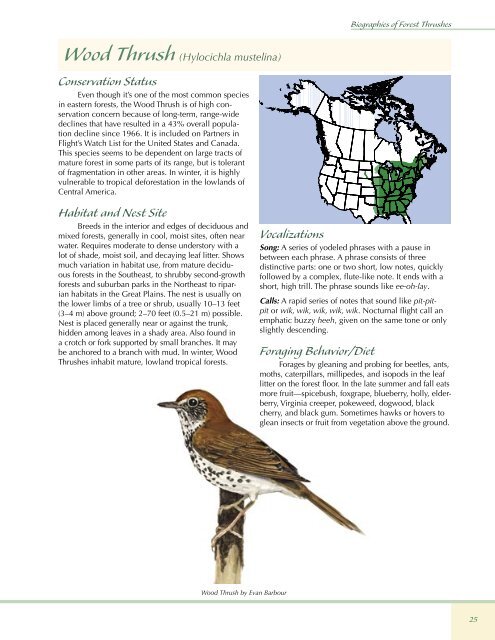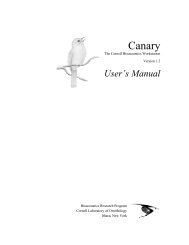A Land Manager's Guide to Improving Habitat for Forest Thrushes
A Land Manager's Guide to Improving Habitat for Forest Thrushes
A Land Manager's Guide to Improving Habitat for Forest Thrushes
Create successful ePaper yourself
Turn your PDF publications into a flip-book with our unique Google optimized e-Paper software.
Wood Thrush (Hylocichla mustelina)<br />
Conservation Status<br />
Even though it’s one of the most common species<br />
in eastern <strong>for</strong>ests, the Wood Thrush is of high conservation<br />
concern because of long-term, range-wide<br />
declines that have resulted in a 43% overall population<br />
decline since 1966. It is included on Partners in<br />
Flight’s Watch List <strong>for</strong> the United States and Canada.<br />
This species seems <strong>to</strong> be dependent on large tracts of<br />
mature <strong>for</strong>est in some parts of its range, but is <strong>to</strong>lerant<br />
of fragmentation in other areas. In winter, it is highly<br />
vulnerable <strong>to</strong> tropical de<strong>for</strong>estation in the lowlands of<br />
Central America.<br />
<strong>Habitat</strong> and Nest Site<br />
Breeds in the interior and edges of deciduous and<br />
mixed <strong>for</strong>ests, generally in cool, moist sites, often near<br />
water. Requires moderate <strong>to</strong> dense unders<strong>to</strong>ry with a<br />
lot of shade, moist soil, and decaying leaf litter. Shows<br />
much variation in habitat use, from mature deciduous<br />
<strong>for</strong>ests in the Southeast, <strong>to</strong> shrubby second-growth<br />
<strong>for</strong>ests and suburban parks in the Northeast <strong>to</strong> riparian<br />
habitats in the Great Plains. The nest is usually on<br />
the lower limbs of a tree or shrub, usually 10–13 feet<br />
(3–4 m) above ground; 2–70 feet (0.5–21 m) possible.<br />
Nest is placed generally near or against the trunk,<br />
hidden among leaves in a shady area. Also found in<br />
a crotch or <strong>for</strong>k supported by small branches. It may<br />
be anchored <strong>to</strong> a branch with mud. In winter, Wood<br />
<strong>Thrushes</strong> inhabit mature, lowland tropical <strong>for</strong>ests.<br />
Wood Thrush by Evan Barbour<br />
Biographies of <strong>Forest</strong> <strong>Thrushes</strong><br />
Vocalizations<br />
Song: A series of yodeled phrases with a pause in<br />
between each phrase. A phrase consists of three<br />
distinctive parts: one or two short, low notes, quickly<br />
followed by a complex, flute-like note. It ends with a<br />
short, high trill. The phrase sounds like ee-oh-lay.<br />
Calls: A rapid series of notes that sound like pit-pitpit<br />
or wik, wik, wik, wik, wik. Nocturnal flight call an<br />
emphatic buzzy heeh, given on the same <strong>to</strong>ne or only<br />
slightly descending.<br />
Foraging Behavior/Diet<br />
Forages by gleaning and probing <strong>for</strong> beetles, ants,<br />
moths, caterpillars, millipedes, and isopods in the leaf<br />
litter on the <strong>for</strong>est floor. In the late summer and fall eats<br />
more fruit—spicebush, foxgrape, blueberry, holly, elderberry,<br />
Virginia creeper, pokeweed, dogwood, black<br />
cherry, and black gum. Sometimes hawks or hovers <strong>to</strong><br />
glean insects or fruit from vegetation above the ground.<br />
25

















